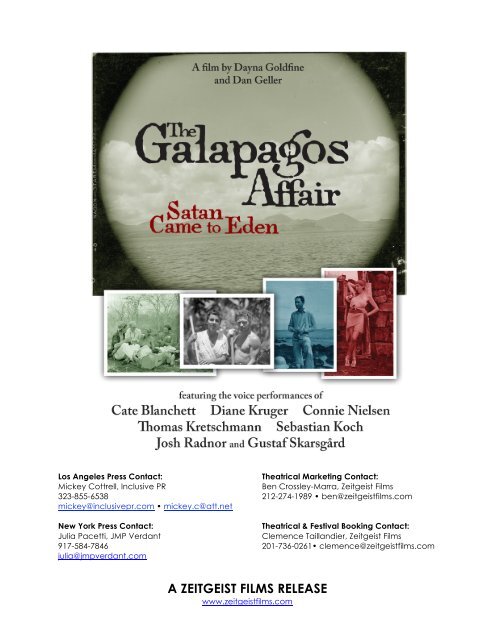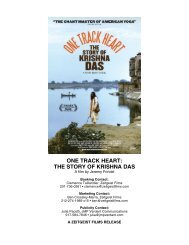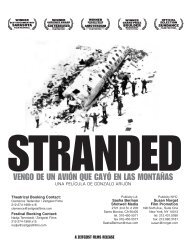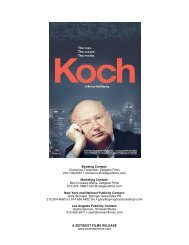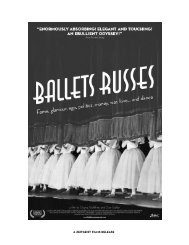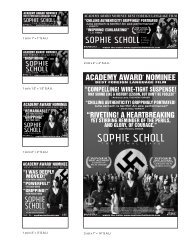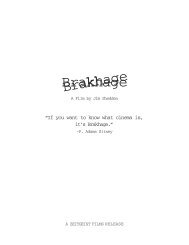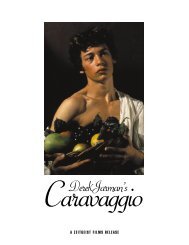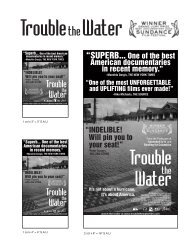Download the Press Kit - Zeitgeist Films.
Download the Press Kit - Zeitgeist Films.
Download the Press Kit - Zeitgeist Films.
You also want an ePaper? Increase the reach of your titles
YUMPU automatically turns print PDFs into web optimized ePapers that Google loves.
Los Angeles <strong>Press</strong> Contact:Mickey Cottrell, Inclusive PR323-855-6538mickey@inclusivepr.com • mickey.c@att.netNew York <strong>Press</strong> Contact:Julia Pacetti, JMP Verdant917-584-7846julia@jmpverdant.comTheatrical Marketing Contact:Ben Crossley-Marra, <strong>Zeitgeist</strong> <strong>Films</strong>212-274-1989 • ben@zeitgeistfilms.comTheatrical & Festival Booking Contact:Clemence Taillandier, <strong>Zeitgeist</strong> <strong>Films</strong>201-736-0261• clemence@zeitgeistfilms.comA ZEITGEIST FILMS RELEASEwww.zeitgeistfilms.com
THE GALAPAGOS AFFAIRSatan Came to EdenDarwin meets Hitchcock in this true-crime tale of paradise found and lost. TheGalapagos Affair: Satan Came To Eden is a fascinating documentary portrait ofa 1930s murder mystery as strange and alluring as <strong>the</strong> famous archipelago itself.Fleeing conventional society, a Berlin doctor and his mistress start a new life onuninhabited Floreana Island. But after <strong>the</strong> international press sensationalizes <strong>the</strong>exploits of <strong>the</strong> Galapagos’ “Adam and Eve”, o<strong>the</strong>rs flock <strong>the</strong>re—including a selfstyledSwiss Family Robinson and a gun-toting Viennese Baroness and her twolovers. Things would never be <strong>the</strong> same.To bring this extraordinary story to life, filmmakers Dayna Goldfine and DanGeller (Ballets Russes) nimbly interweave newly unear<strong>the</strong>d home movies of<strong>the</strong>se original settlers; testimonies of modern day islanders; stunning HD footageof native flora and fauna; and powerful voice performances by Oscar® winnerCate Blanchett, Diane Kruger, Connie Nielsen, Sebastian Koch, ThomasKretschmann, Gustaf Skarsgård and Josh Radnor. Macabre yet inspiring, TheGalapagos Affair is a gripping parable of Robinson Crusoe adventure andutopian dreams gone awry.
LONG SYNOPSISDarwin meets Hitchcock in this murder-mystery documentary. THE GALAPAGOS AFFAIR:SATAN CAME TO EDEN is a gripping tale of idealistic dreams of paradise gone awry, set in <strong>the</strong>brutal yet alluring landscape of <strong>the</strong> Galapagos Islands. Featuring <strong>the</strong> voice performances ofinternational stars Cate Blanchett, Diane Kruger, Connie Nielsen, Sebastian Koch, ThomasKretschmann, Gustaf Skarsgård and Josh Radnor, this film explores an unsolved 1930s murdermystery that occurred on <strong>the</strong> Galapagos Island of Floreana.In 1929, Berlin physician Friedrich Ritter (Thomas Kretschmann) left Germany with his lover DoreStrauch (Cate Blanchett) to make a life on <strong>the</strong> uninhabited island of Floreana. He envisioned aparadise of solitude in which he would write great philosophical tracts while carving out arudimentary existence based on Nietzsche's doctrine of <strong>the</strong> Superman. What Ritter and Strauchdid not count on was being discovered by <strong>the</strong> international press, who rapidly trumpeted <strong>the</strong>irexploits as “The Adam and Eve of <strong>the</strong> Galapagos.”With this fame o<strong>the</strong>rs flocked to <strong>the</strong> shores of Floreana, each seeking to realize his or her ownpersonal ambitions. The first “intruders” on Ritter's solitude were <strong>the</strong> Wittmer family: Heinz(Sebastian Koch), his pregnant wife Margret (Diane Kruger) and teenage son Harry, who leftCologne, Germany, in 1931 determined to become “The Swiss Family Robinsons of <strong>the</strong>Galapagos.” Then, shortly <strong>the</strong>reafter, <strong>the</strong> Austrian Baroness Eloise von Wagner Bosquet (ConnieNielsen) arrived, toting a revolver, a pair of handsome, much younger lovers and a grandiose planto build a luxury hotel catering to billionaire yachtsmen. These three groups, each with <strong>the</strong>ir ownpersonal mythologies and visions of what paradise might be, quickly discovered that <strong>the</strong> island ofFloreana would never be large enough for peaceful cohabitation. THE GALAPAGOS AFFAIR<strong>the</strong>n becomes <strong>the</strong> tale of disparate dreams colliding in a harsh environment barely capable ofsupporting human life: it is a portrait of mysterious disappearances and likely murder for some, ofsurvival and triumph for o<strong>the</strong>rs. As <strong>the</strong> story unspools, Josh Radnor voices <strong>the</strong> observing eye ofJohn Garth, a young American scientist, and Gustaf Skarsgård is <strong>the</strong> Swedish journalist, RolfBlomberg, who comes to investigate <strong>the</strong> Island’s disappearances.In addition to <strong>the</strong> richness of this real-life mystery (a mystery that rivals what Alfred Hitchcock orAgatha Christie might have dreamt up), THE GALAPAGOS AFFAIR also skillfully interweaves <strong>the</strong>stories of a handful of present-day Galapagos pioneers (Europeans, Americans and Ecuadoreanswho settled idiosyncratically on <strong>the</strong> Islands between <strong>the</strong> 1930s and 1960s). Interviews and veritescenes with <strong>the</strong>se modern “characters” touch upon many of <strong>the</strong> myriad reasons that <strong>the</strong> originalsettlers left civilization behind to take up permanent residency on <strong>the</strong> Galapagos.Through a mixture of contemporary footage and archival stills we meet: Jacqueline De Roy (who,with her husband and young daughter, left Belgium in search of a way out of <strong>the</strong> post-war rut);Teppy Angermeyer (whose fa<strong>the</strong>r, Gus, fled Hitler's Germany with his three bro<strong>the</strong>rs in pursuit ofa paradise made of fresh air, love and sunshine); Carmen Kubler (whose family migrated to <strong>the</strong>Galapagos in 1934 after her fa<strong>the</strong>r “smelled war” brewing in Europe); and Steve Divine (whosehardy, individualist parents established a farm in <strong>the</strong> Galapagos highlands).THE GALAPAGOS AFFAIR features newly-discovered vintage “home movie” footage of <strong>the</strong>protagonists in <strong>the</strong>ir Galapagos surroundings and o<strong>the</strong>r extraordinary archival material not seen inover 70 years. Stunning present-day HD footage evokes <strong>the</strong> unique atmosphere and naturalbeauty of <strong>the</strong> Galapagos Islands while portraying <strong>the</strong> inner lives of those who chose to make<strong>the</strong>se Islands <strong>the</strong>ir home.By turns macabre, humorous, inspiring and profound, THE GALAPAGOS AFFAIR is a murdermystery but also an adventure story of <strong>the</strong> sort that make Robinson Crusoe and The Swiss FamilyRobinson so timeless.
FILMMAKERS’ STATEMENT & PRODUCTION NOTESIn <strong>the</strong> summer of 1998, we were hired by a friend of ours as cinematographer and soundrecordist for a National Science Foundation-funded project in <strong>the</strong> Galapagos Islands. Little didwe know that a two-week shoot-for-hire would result in a deep passion for a place and a story, apassion that would take us on a 15-year journey resulting in THE GALAPAGOS AFFAIR: SatanCame to Eden.At <strong>the</strong> time, we had no idea that people lived in <strong>the</strong> Galapagos. Like most travelers going <strong>the</strong>refor <strong>the</strong> first time, we believed that <strong>the</strong> Islands’ only inhabitants were exotic species of tortoises,birds and iguanas, and that <strong>the</strong>ir history consisted entirely of scientific exploration related toDarwin and his followers. It was a wonderful surprise <strong>the</strong>n, when early in this shoot, we pulled abook called The Enchanted Islands: The Galapagos Discovered out of our boat’s one-shelf“library” and began reading with growing excitement about <strong>the</strong> Islands’ little-known humanhistory. One chapter in particular captured our attention. It was called “Murder in Paradise” andits scant twelve pages introduced us to Dr. Friedrich Ritter, his companion Dore Strauch, <strong>the</strong>Wittmer family, <strong>the</strong> Baroness, her lovers and <strong>the</strong> mysterious events that took place on FloreanaIsland in <strong>the</strong> early 1930s.Our excitement grew when Miguel, our Galapagos guide and naturalist, told us that one of <strong>the</strong>key protagonists, Margret Wittmer—<strong>the</strong>n 95 years old—was still living on Floreana. From thatmoment on, we were determined to somehow meet Margret before we left <strong>the</strong> Islands. Althoughour itinerary did not include Floreana, toward <strong>the</strong> end of our shoot, through some oddcoincidence, our boat ended up breaking down right in front of that island. Luckily for us, <strong>the</strong>rewas nothing to do but clamber ashore and have tea with Margret while <strong>the</strong> crew repaired <strong>the</strong>boat. Before meeting her, our guide sternly warned us not to utter a word about <strong>the</strong> Baroness orany of <strong>the</strong> strange details surrounding her disappearance. Taking his warning to heart, weinstead listened as Margret regaled us with stories of Franklin Roosevelt and o<strong>the</strong>r famousvisitors to her island. As expected, she never uttered a word about Floreana’s more notorioushistory. But just as we were getting ready to say goodbye, Margret looked closely at us andmade a statement that would haunt us in <strong>the</strong> years to come: “En la boca cerada, no entranmoscas,” or “A closed mouth admits no flies.”When Margret uttered that phrase we became obsessed with <strong>the</strong> Floreana story and knewimmediately that <strong>the</strong>re was a great film inherent in it, but we were stymied about how this storycould be told in a documentary. With <strong>the</strong> exception of Margret (who wouldn’t talk about it), all <strong>the</strong>protagonists were dead and we aren’t <strong>the</strong> kind of documentarians who use re-enactments in ourwork. So we left <strong>the</strong> Galapagos and continued to mull over this fabulous yarn as we beganinstead to work on BALLETS RUSSES (2005).Then, years later, as we were finishing BALLETS RUSSES, <strong>the</strong> friend who’d taken us to <strong>the</strong>Galapagos in 1998 called with some extremely exciting news. He’d heard about a hiddenarchive at USC, which had been donated decades earlier by Allan Hancock, a wealthy Sou<strong>the</strong>rnCalifornia industrialist. Rumor had it that this archive contained 16mm film footage from <strong>the</strong>1930s featuring all of <strong>the</strong> protagonists in <strong>the</strong> Floreana mystery. Knowing that we were stillconsumed by a passion for this unsolved whodunit, our friend made <strong>the</strong> introductions necessaryto get access to this archive and, along with our fellow producer Celeste Schaefer Snyder, wemade a trip down to Los Angeles to check it out.
At USC, each film can we opened smelled strongly of vinegar, a sign of decay, and <strong>the</strong> reelswere in varying states of disintegration. Not knowing anything about <strong>the</strong> quality of <strong>the</strong> images or<strong>the</strong> real content of <strong>the</strong>se films, but realizing that it was only a matter of time before <strong>the</strong>y would becompletely unsalvageable, we worked with USC archivist Melinda Hayes to come to anagreement with <strong>the</strong> university: in return for <strong>the</strong> right to use <strong>the</strong> footage as <strong>the</strong> basis of adocumentary, we would cover <strong>the</strong> cost and take responsibility for transferring it to a more stablemedium.As <strong>the</strong> fragile celluloid unspooled at Monaco Labs in San Francisco we knew our gamble hadpaid off. There in front of us were Friedrich Ritter and Dore Strauch building <strong>the</strong>ir homestead onFloreana, <strong>the</strong> Wittmers up in <strong>the</strong> highlands in <strong>the</strong> old pirate caves, and <strong>the</strong> Baroness vampingwith Philippson, her favored lover. The images offered up an incredibly privileged view into <strong>the</strong>long-vanished people and events that had filled our imaginations for so many years. With greatexcitement we realized we could finally tell this story as a documentary.After transferring <strong>the</strong> footage to tape and cataloguing it, we began what would be a year’s longresearch phase. This included many trips back to USC to pour through <strong>the</strong>ir Allan HancockCollection—which in addition to <strong>the</strong> 16mm film footage, includes hundreds of photographs andnegatives, letters, journals, books and manuscripts all related to Floreana and <strong>the</strong> events of1931–1934. It also involved countless eBay searches that unear<strong>the</strong>d magazine articles from <strong>the</strong>period, more photos and an extremely rare copy of Dore Strauch’s book, Satan Came to Eden.Along <strong>the</strong> way, we befriended John Woram, one of <strong>the</strong> most avid investigators into <strong>the</strong> humanhistory of <strong>the</strong> Galapagos and creator of <strong>the</strong> website Las Encantadas http://www.galapagos.to/John generously introduced us to Jorge Antonio Mahauad, <strong>the</strong> great grandson of MargretWittmer. Jorge Antonio had spent <strong>the</strong> years since Margret’s death in 2000 trying to piecetoge<strong>the</strong>r and preserve <strong>the</strong> Wittmer family history and he was quick to embrace our plans tomake a documentary.John Woram also made email introductions to Octavio Latorre and Jose Machuca, <strong>the</strong> twoEcuadorean historians who have each spent much of <strong>the</strong> past several decades uncovering <strong>the</strong>human history of <strong>the</strong> Islands, and who toge<strong>the</strong>r serve as quasi-guides through <strong>the</strong> narrative ofour film. Finally, our location production manager (and naturalist/guide on our original trip toGalapagos), Miguel Mosquera, arranged for us to meet Claudio Cruz, who grew up on FloreanaIsland on <strong>the</strong> old Ritter/Strauch property.With <strong>the</strong>se introductions in hand, we travelled back to <strong>the</strong> Galapagos on a research trip in <strong>the</strong>spring of 2007. Initially we thought we would spend <strong>the</strong> bulk of <strong>the</strong> trip on Floreana, visiting <strong>the</strong>locations of <strong>the</strong> 1930s incidents and meeting Margret Wittmer’s daughter Floreanita, who stillruns <strong>the</strong> hotel <strong>the</strong>re. But before sailing to Floreana, we stopped on <strong>the</strong> nearby (and much morepopulated) island of Santa Cruz to visit Jose Machuca and meet Margret’s son Rolf Wittmer.While on Santa Cruz, we were introduced to several long-time settlers and <strong>the</strong>ir descendants:Jacqueline, Tui and Gil De Roy, Carmen and Teppy Angermeyer, Steve Divine and DanielFitter, among o<strong>the</strong>rs. In talking with <strong>the</strong>se original “Galapagueños,” as Island settlers are called,we discovered that <strong>the</strong>ir experiences in many ways reflected <strong>the</strong> experiences of ourprotagonists on Floreana. We saw that <strong>the</strong>ir stories could both provide context for <strong>the</strong> murdermystery and amplify many of <strong>the</strong> <strong>the</strong>mes that had come to <strong>the</strong> fore during our research. In short,our film was expanding beyond a “whodunit” and into an exploration of humanity’s perennialsearch for paradise. And indeed, it was going to take on <strong>the</strong> same sort of multi-characternarratives that had worked so well for us in BALLETS RUSSES, KIDS OF SURVIVAL and o<strong>the</strong>rearlier documentaries we’d made.
In September 2007, we returned to <strong>the</strong> Islands with our camera, microphone, a permit from <strong>the</strong>Galapagos National Park, and our crew (largely made up of friends who had volunteered <strong>the</strong>irservices to our cause). We spent more than a month filming at <strong>the</strong> Floreana locations related to<strong>the</strong> murder mystery, shooting interviews with more than two dozen people, and traveling by boatto <strong>the</strong> surrounding islands in order to capture <strong>the</strong> atmosphere and wildlife that make <strong>the</strong>Galapagos so unique.That trip was only <strong>the</strong> first of what would ultimately be five to <strong>the</strong> Islands, and our productionwork would also include travels to Norway where we interviewed Jacob Lundh and FriedelHorneman, and Germany where we interviewed Friedrich Ritter’s grandnephew, Fritz Hieber,and filmed in Wollbach, Ritter’s childhood home.Back in San Francisco, we tapped <strong>the</strong> extremely talented editor Bill Weber (WE WERE HERE,THE COCKETTES) to wrestle <strong>the</strong> tangled stories that make up THE GALAPAGOS AFFAIR intoa dramatic whole. Throughout <strong>the</strong> editing, we, along with Celeste, continually wrote and refined ascript based on <strong>the</strong> prolific writings of <strong>the</strong> protagonists in <strong>the</strong> Floreana story. These writingswould serve as <strong>the</strong> first-person voicings of dreams and resentments against which <strong>the</strong> vintagearchival footage would play.As <strong>the</strong> script came toge<strong>the</strong>r, we knew we were going to need first-rate actors in order tosuccessfully bring to life Friedrich, Dore, <strong>the</strong> Baroness and <strong>the</strong> rest of <strong>the</strong> Floreana protagonists.When Cate Blanchett came to San Francisco to film BLUE JASMINE we were introduced by amutual friend. On a break from filming with Woody Allen, Cate was kind enough to come up toour house and watch a cut of THE GALAPAGOS AFFAIR. We were completely in simpaticowith her take on <strong>the</strong> film and especially by <strong>the</strong> way she perceived <strong>the</strong> many layers of <strong>the</strong>character of Dore Strauch. Having seen Cate in THE GOOD GERMAN, we knew she was morethan capable of delivering a knockout performance with a German accent and so when shegenerously agreed to voice <strong>the</strong> role, we knew we could truly bring Dore to life.With Cate on board, our Executive Producer, Jonathan Dana, introduced us to casting directorMargery Simkin (BEAUTIFUL CREATURES, AVATAR, TWELVE MONKEYS), who brought tous <strong>the</strong> rest of <strong>the</strong> amazing cast: Diane Kruger as Margret Wittmer, Sebastian Koch as Margret’shusband Heinz, and a truly dark and menacing Thomas Kretschmann as Friedrich Ritter.Margery also brought on board <strong>the</strong> fabulous Connie Nielsen as <strong>the</strong> Baroness, Josh Radnor as<strong>the</strong> young American scientist John Garth and Gustaf Skarsgård as <strong>the</strong> Swedish journalist RolfBlomberg.For <strong>the</strong> original score we turned to Laura Karpman, who had worked with us on our lastdocumentary, SOMETHING VENTURED. Laura understood that <strong>the</strong> music needed to besomething a little off-kilter and weird to reflect <strong>the</strong> Galapagos atmosphere, but also expansiveenough to embody <strong>the</strong> hopes and dreams of <strong>the</strong> many characters featured in <strong>the</strong> film. As luckwould have it, we began working with Laura just as she was heading off to teach at <strong>the</strong>Valencia, Spain campus of <strong>the</strong> Berklee College of Music. While <strong>the</strong>re she discovered acollection of unbelievably talented young musicians who in addition to playing <strong>the</strong> conventionalviolin, guitar and cello, also were adept at more unusual instruments including <strong>the</strong> chromaticdidgeridoo, Indian singing bowls, and <strong>the</strong> Latin American cuatro. Laura’s brilliance as acomposer and orchestrator inspired <strong>the</strong>se talented musicians and resulted in what we feel is atruly beguiling score.
THE CHARACTERSFloreana Mystery Protagonists (in order of appearance)Dore Strauch (voiced by Cate Blanchett):Dore Strauch was born in Berlin, Germany. She was 28-years-oldwhen, in July 1929, she left Berlin (and her husband) behind in order tomigrate permanently to <strong>the</strong> uninhabited Galapagos island of Floreanawith her lover and physician, Dr. Friedrich Ritter. Ritter and Strauchcalled <strong>the</strong>ir Floreana homestead “Friedo”—a melding of <strong>the</strong>ir firstnames—and were dubbed “The Adam and Eve of <strong>the</strong> Galapagos” by<strong>the</strong> world’s press. In 1935, Dore published her book Satan Came toEden in which she provided her version of <strong>the</strong> events on Floreana.Friedrich Ritter (voiced by Thomas Kretschmann):Friedrich Ritter was born in <strong>the</strong> little town of Wollbach near Germany’sBlack Forrest. He was a respected physician in Berlin when, in July1929 at <strong>the</strong> age of 43, he left his flourishing practice (and his wife)behind to follow a life-long dream of renouncing civilization for life on anuninhabited island. Ritter chose to settle in <strong>the</strong> Galapagos along withhis lover and patient, Dore Strauch, after reading William Beebe’spopular book, Galapagos World’s End. A devout follower of Nietzsche,Ritter hoped to become a great, published philosopher in his own rightwhile emulating <strong>the</strong> Nietzschean doctrine of <strong>the</strong> Superman on <strong>the</strong>island of Floreana. Ritter and Strauch called <strong>the</strong>ir Floreana homestead“Friedo”—a melding of <strong>the</strong>ir first names—and were dubbed “The Adamand Eve of <strong>the</strong> Galapagos” by <strong>the</strong> world’s press.John Garth (voiced by Josh Radnor):Biologist John Garth was only 21 years old when, in <strong>the</strong> winter of 1931,he boarded <strong>the</strong> research vessel Velero III for its first expedition to <strong>the</strong><strong>the</strong>n-largely uncharted Galapagos Islands. The Velero’s captain wasAllan Hancock, Sou<strong>the</strong>rn California oilman, banker, philanthropist andpatron of pure scientist. Hancock was a gifted cellist who never sailedanywhere without his own personal chamber orchestra, and he tappedGarth because, although Garth was not yet established as a scientist,he was already an extremely accomplished pianist. Nicknamed “Bugs”because of his focus on entomology, Garth was a careful journalkeeper. His writing (which covers <strong>the</strong> period of <strong>the</strong> Velero III annualexpeditions between 1931 and 1935) provides an observationalperspective on <strong>the</strong> Floreana people and events.
Margret Wittmer (voiced by Diane Kruger):In <strong>the</strong> summer of 1931, 27-year-old Margret Wittmer left Cologne,Germany, with her husband Heinz and her 14-year-old stepson Harry.The Wittmer’s were middle-class Germans who sought a new life in <strong>the</strong>Galapagos both as a way out of <strong>the</strong> grim economic and political realitiesof 1930s Germany, and as a healthful place in which <strong>the</strong>y hoped Harrywould recover from what was probably rheumatic heart disease. Theywere inspired to migrate to <strong>the</strong> Islands by articles that were written byand about Friedrich Ritter in <strong>the</strong> German newspapers, and fancied<strong>the</strong>mselves becoming “The Swiss Family Robinsons of <strong>the</strong> Galapagos.”The Wittmers chose Floreana in particular because Ritter was aphysician and Margret, five months pregnant with her first child when<strong>the</strong>y landed on <strong>the</strong> Island, hoped <strong>the</strong> doctor would help her through herimpending labor. In 1959, Margret wrote her version of <strong>the</strong> Floreanastory in her book Floreana: A Woman’s Pilgrimage to <strong>the</strong> Galapagos.Heinz Wittmer (voiced by Sebastian Koch):41-year-old Heinz Wittmer was working as personal secretary to <strong>the</strong>mayor of Cologne when, discouraged by <strong>the</strong> grim economic and politicalrealities of 1930s Germany, and concerned about <strong>the</strong> fragile health of his14-year-old son Harry, he read a series of newspaper articles written byFriedrich Ritter. These articles inspired him deeply and he soonconvinced his new wife, Margret, to leave everything behind and movepermanently to <strong>the</strong> Galapagos. The Wittmers landed on Floreana inAugust 1931 and from <strong>the</strong> beginning fancied <strong>the</strong>mselves “The SwissFamily Robinsons of <strong>the</strong> Galapagos.”Baroness Eloise von Wagner (voiced by Connie Nielsen):The Austrian Baroness von Wagner landed on Floreana in October 1931along with two much younger German lovers, Robert Philippson andRudolf Lorenz. Having read reports of <strong>the</strong> wealthy yachtsmen whovisited Friedrich Ritter and Dore Strauch, <strong>the</strong> Baroness came to <strong>the</strong>Galapagos determined to build a grand luxury hotel for <strong>the</strong>se passingmillionaires. The hotel was to have been called Hacienda Paradiso.Although it has never been proven, <strong>the</strong> Baroness claimed to be related to<strong>the</strong> composers Liszt and Wagner, and also to have spent time as a spyin Constantinople during World War I. She and Lorenz owned aboutique toge<strong>the</strong>r in Paris, which <strong>the</strong>y gave up in order to seek <strong>the</strong>irfame and fortune on Floreana. It is believed that Lorenz provided <strong>the</strong>money for <strong>the</strong>ir trip and that Philippson had been a salesman in <strong>the</strong> Parisboutique.
Rolf Blomberg (voiced by Gustaf Skarsgård):Rolf Blomberg was a 22-year-old Swedish journalist and photographerwho visited Floreana, along with Norwegian fisherman TrygveNuggerud, in <strong>the</strong> summer of 1934. Blomberg had come to <strong>the</strong> Islandintent on meeting <strong>the</strong> Baroness and was <strong>the</strong> first outsider to learn ofher disappearance. He <strong>the</strong>n became <strong>the</strong> reporter who broke <strong>the</strong> storyto <strong>the</strong> international press. After World War II, Blomberg settledpermanently in Ecuador and, with that as his base, produced morethan 30 documentaries for Swedish television. Some of his footageappears in THE GALAPAGOS AFFAIR.Modern Characters (in order of appearance)Octavio Latorre:Historian Octavio Latorre lives in Quito, Ecuador and haswritten extensively on <strong>the</strong> human history of <strong>the</strong> GalapagosIslands. His first and most well-known book is The Curseof <strong>the</strong> Giant Tortoise: Tragedies, Mysteries and Crimes inThe Galapagos Islands.Fritz Hieber:Fritz Hieber is <strong>the</strong> grandnephew of Friedrich Ritter. Hegrew up in Brombach, Germany—not far from Wollbach,<strong>the</strong> childhood home of Friedrich. Throughout his youth Fritzwas told countless stories about Ritter, Dore Strauch ando<strong>the</strong>r Floreana inhabitants, and he eloquently relatessome of <strong>the</strong>se stories in <strong>the</strong> film. Hieber now lives nearFrankfurt, and like his granduncle, is a physician..Jacqueline and Gil De Roy:Belgian expatriate Jacqueline De Roy immigrated toSanta Cruz Island in 1955 along with her late husbandAndre and <strong>the</strong>ir two-year-old daughter Tui. Her son Gilwas born on Santa Cruz in 1958. Both of <strong>the</strong>m still liveon <strong>the</strong> Island.
Tui De Roy:The daughter of Jacqueline and <strong>the</strong> late Andre De Roy, Tuimoved to Santa Cruz Island from Belgium when she wastwo-years-old. Tui is a world-renowned wildlifephotographer and writer whose books include Galapagos:Islands Lost in Time; Galapagos: Islands Born of Fire; TheAndes: As <strong>the</strong> Condor Flies; and New Zealand: A NaturalHistory. She now makes her home in New Zealand.Teppy Angermeyer:Born in <strong>the</strong> Galapagos, Teppy Angermeyer is <strong>the</strong> son ofGus Angermeyer—<strong>the</strong> eldest of <strong>the</strong> four Angermeyerbro<strong>the</strong>rs who immigrated permanently to Santa Cruz Islandfrom Hamburg, Germany, in 1935. Gus and his bro<strong>the</strong>rs—Karl, Hans and Fritz—all fled due to <strong>the</strong> rise of Hitler.Steve Divine:Steve’s fa<strong>the</strong>r, Bud Divine, was a rough and tumblerancher from Arizona who, along with his wife Doris,migrated permanently to <strong>the</strong> Galapagos in 1949. Stevewas born on Santa Cruz in 1952 and still lives <strong>the</strong>retoday.Carmen Kubler Angermeyer:.In 1934, Carmen Angermeyer was six years old when sheemigrated from Spain to Santa Cruz Island with her parentsCarlos and Marga Kubler. Carmen refers to herself as “ahousewife in Galapagos” and married Fritz, <strong>the</strong> youngest of<strong>the</strong> Angermeyer bro<strong>the</strong>rs. Shortly after Carmen marriedFritz, her mo<strong>the</strong>r Marga divorced Carlos Kubler in order tomarry Fritz’s bro<strong>the</strong>r Karl Angermeyer.
Jacob Lundh:In 1932, when he was eight years old, Jacob Lundh movedto Santa Cruz Island from Oslo, Norway, with his mo<strong>the</strong>rand fa<strong>the</strong>r. His fa<strong>the</strong>r, Captain Herman Lundh, ran a cargoboat around <strong>the</strong> Galapagos Islands and knew all of <strong>the</strong>protagonists of <strong>the</strong> Floreana mystery. He even spent aweekend at Hacienda Paradiso with <strong>the</strong> Baroness and herlovers. We filmed Lundh at his home in Oslo.Daniel Fitter Angermeyer:Born on Santa Cruz Island in 1970, Daniel is <strong>the</strong> thirdgenerationof Angermeyers to live in Galapagos. Hismo<strong>the</strong>r Mary was <strong>the</strong> daughter of Hans Angermeyer, whoalong with his bro<strong>the</strong>rs Gus, Karl and Fritz, emigratedfrom Hamburg, Germany, in 1935.Rolf Wittmer and Jorge Antonio Mahauad:The son of Margret and Heinz Wittmer, RolfWittmer was born on January 1, 1933, only fourmonths after his parents landed on Floreana.Rolf’s delivery took place in one of <strong>the</strong> Island’s oldpirate caves, which is where <strong>the</strong> Wittmers lived at<strong>the</strong> time. Jorge Antonio Mahauad is Rolf’s oldestgrandson. He was born in Ecuador, but now liveson Santa Cruz Island.Floreanita Wittmer:The daughter of Margret and Heinz Wittmer, Floreanitawas born on Floreana in 1937. By <strong>the</strong> time of her birth, <strong>the</strong>Wittmers lived in a house and <strong>the</strong> old pirate caves wereused only for storage. Floreanita still lives on Floreanaand runs <strong>the</strong> family’s hotel <strong>the</strong>re.
Friedel Horneman:The daughter of a Norwegian fa<strong>the</strong>r and a Germanmo<strong>the</strong>r, Friedel Horneman was born in <strong>the</strong> Santa Cruzhighlands in 1940. Friedel describes her childhood inidyllic terms, but as she grew into young womanhood, shedreamt of leaving <strong>the</strong> Galapagos and began looking for away out—especially when her parents tried to marry heroff to Alf Kastdalen, <strong>the</strong> son of neighboring Norwegianimmigrants. Friedel now makes her home with her secondhusband in Kirkenes, Norway.Jose Machuca:A retired ship’s physician from Guayaquil, Ecuador, Dr.Jose Machuca moved to <strong>the</strong> island of Santa Cruz in 1993.Since <strong>the</strong>n he has become known as an amateur historianand scholar of all things related to Galapagos humanhistory.Claudio Cruz:The son of Eliezer and Emma Cruz, Claudio is one oftwelve Cruz children born on Floreana Island. He grew upon <strong>the</strong> property that had formerly been known as Friedoand was owned previously by Friedrich Ritter and DoreStrauch. In fact, Dr. Ritter’s grave remains undisturbed on<strong>the</strong> Cruz property to this day.
JONATHAN DANA (EXECUTIVE PRODUCER)Jonathan Dana has been a pioneer in <strong>the</strong> independent film business since 1971. He served asPresident of Motion Pictures and Television at Atlantic Releasing Corporation and as President andCEO of Triton Pictures, supervising such films as A WORLD APART (1988), STORMY MONDAY(1988), TEEN WOLF (1985), PATTY HEARST (1988) and HEARTS OF DARKNESS: AFILMMAKER’S APOCALYPSE (1991). Dana has also served in a production capacity on over 26fiction and non-fiction films, including STANDING IN THE SHADOWS OF MOTOWN (2002), THESPITFIRE GRILL (1996), TOM DOWD AND THE LANGUAGE OF MUSIC (2003), YOU KILL ME(2007) and KILL THE IRISHMAN (2011), and directed <strong>the</strong> ground-breaking documentarySANDSTONE (1975). His recent credits as producer's representative include <strong>the</strong> 2012 Spirit Awardnominee WE WERE HERE and 2013 Oscar nominee THE INVISIBLE WAR. Dana was an initialinvestor and supervised <strong>the</strong> launch of indie film community Withoutabox.com, now an operatingdivision of IMDB. This is his third collaboration with Geller Goldfine, having served as consultingproducer and producer’s representative on BALLETS RUSSES (2005), and as production consultanton SOMETHING VENTURED (2011).ROY WALDSPURGER (SOUND DESIGNER/MIXER)Roy Waldspurger has been a sound editor, designer and mixer for nearly 20 years. His mostrecent credits include Sophia Coppola’s THE BLING RING (2013), SOMEWHERE (2010) andMARIE ANTOINETTE (2006), David Mamet/HBO’s PHIL SPECTOR (2013), and Curtis Hanson’sTOO BIG TO FAIL (2011).MARGERY SIMKIN (CASTING DIRECTOR)Over <strong>the</strong> past thirty years, Margery Simkin has cast films for major directors such as Guillermo delToro, James Cameron, Steven Soderbergh and Terry Gilliam. Among many o<strong>the</strong>rs, her creditsinclude: BEAUTIFUL CREATURES (2013), AVATAR (2009), TWELVE MONKEYS (1995),MARLEY AND ME (2008), ERIN BROKOVICH (2000), FREEDOM WRITERS (2007), FIELD OFDREAMS (1989), TOP GUN (1986), and most recently, PACIFIC RIM (2013).CELESTE SCHAEFER SNYDER (PRODUCER/WRITER)Celeste Schaefer Snyder also co-produced and co-wrote SOMETHING VENTURED (2011), andassociate produced and co-wrote BALLETS RUSSES (2005).
THE ACTORSCATE BLANCHETT (DORE STRAUCH)Currently receiving rave reviews for her performance in Woody Allen’s BLUE JASMINE, CateBlanchett is an Australian actress, who has received several accolades, including a star on <strong>the</strong>Hollywood Walk of Fame, two Screen Actors Guild Awards, two Golden Globe Awards, two BAFTAs,and an Academy Award. She came to international attention for her role as Elizabeth I of England in<strong>the</strong> 1998 film ELIZABETH for which she won British Academy of Film and Television Arts (BAFTA)and Golden Globe awards, and earned her first Academy Award nomination for Best Actress.Blanchett appeared as <strong>the</strong> elf lady Galadriel in Peter Jackson's THE LORD OF THE RINGS trilogyfrom 2001 to 2003. In 2004, Blanchett's portrayal of Katharine Hepburn in Martin Scorsese's THEAVIATOR brought her numerous awards, including an Academy Award for Best Supporting Actress.Blanchett's o<strong>the</strong>r films include BABEL (2006), NOTES ON A SCANDAL (2006), INDIANA JONESAND THE KINGDOM OF THE CRYSTAL SKULL (2008), and THE CURIOUS CASE OF BENJAMINBUTTON (2008). Blanchett collaborated with director Peter Jackson again for THE HOBBIT (2012–2014). She will star in George Clooney’s upcoming THE MONUMENTS MEN.SEBASTIAN KOCH (HEINZ WITTMER)On stage, television, and <strong>the</strong> big screen, Sebastian Koch is undeniably one of Germany’s mostmulti-faceted and successful actors. He starred in <strong>the</strong> Academy Award-winning THE LIVES OFOTHERS (2006), for which he received <strong>the</strong> Globo d'Oro for Best European Actor from <strong>the</strong> ItalianForeign <strong>Press</strong>. Koch also starred in Paul Verhoeven’s BLACK BOOK (2006), which premiered inVenice and Toronto and was The Ne<strong>the</strong>rlands’ Oscar submission for <strong>the</strong> Best Foreign LanguageFilm. Most recently he appeared in A GOOD DAY TO DIE HARD (2013), and is starring in <strong>the</strong>upcoming Showtime production THE VATICAN, directed by Ridley Scott.THOMAS KRETSCHMANN (FRIEDRICH RITTER)Kretschmann is a German actor best known for his performances in Academy Award-winningTHE PIANIST (2002), DOWNFALL (2004) and KING KONG (2005). His prior voice work includes<strong>the</strong> voice of Professor Z in CARS 2 (2011). Kretschmann’s many o<strong>the</strong>r credits include major rolesin TRANSSIBERIAN (2008), SEA WOLF (2008) and VALKYRIE (2008). Currently he is costarringas Van Helsing in NBC’s DRACULA, debuting this October.DIANE KRUGER (MARGRET WITTMER)Kruger is a German actress best known for her role as Bridget von Hammersmark in <strong>the</strong> AcademyAward-nominated INGLORIOUS BASTERDS (2009) and her performances of Marie Antoinette inFAREWELL, MY QUEEN (2012) and Helen in TROY (2004). She also starred in JOYEAUXNOEL (2005), which received a Best Foreign Language Oscar nomination, and played leadingroles in UNKNOWN (2011), MR. NOBODY (2009) and NATIONAL TREASURE (2007). CurrentlyKruger is starring as Detective Sonya Cross in FX Channel’s THE BRIDGE.
CONNIE NIELSEN (BARONESS ELOISE VON WAGNER)Danish actress Connie Nielsen is best known for her portrayal of Princess Lucilla, oppositeRussell Crowe’s Maximus in Ridley Scott’s GLADIATOR (2000). Nielsen’s many o<strong>the</strong>r leadingroles include: THE HUNTED (2003), BROTHERS (2004), RETURN TO SENDER (2004), THEICE HARVEST (2005), and LOST IN AFRICA (2010). Most recently she starred as Meredith Kanealongside Kelsey Grammer in BOSS (STARZ/Lionsgate Television).JOSH RADNOR (JOHN GARTH)Radnor is an American actor who made his writing and directorial debut with <strong>the</strong> 2010 comedydramafilm HAPPYTHANKYOUMOREPLEASE, in which he also starred and for which he won <strong>the</strong>Sundance Film Festival Audience Award. His second film, LIBERAL ARTS (2012), which he againwrote, directed and starred in, also premiered at Sundance. Radnor has co-starred as Ted Mosbyin CBS’s smash hit HOW I MET YOUR MOTHER since 2005.GUSTAF SKARSGÅRD (ROLF BLOMBERG)Named one of European Film’s “Shooting Stars” in 2007, Skarsgård is a member of <strong>the</strong> renownedSwedish Skarsgård acting family, which includes his fa<strong>the</strong>r Stellan, and his bro<strong>the</strong>rs Alexanderand Bill. His most recent credits include leading roles in KON-TIKI (2012), HAPPY END (2011)and TRUST ME (2010). Skarsgård is currently co-starring in History Channel’s VIKINGS.
Trouble in Paradise by Scott FoundasAug 30, 2013This interview with Dayna Goldfine and Dan Geller was published during <strong>the</strong> 2013 Telluride Film Festival inhttp://www.watchnewspapers.comThe “Galapagos Affair,” as it is commonly known, refers to two unexplained disappearances and a series ofmysterious “accidental” deaths that occurred in 1934 on and around <strong>the</strong> tiny island of Floreana, in <strong>the</strong> Galapagosarchipelago—a bizarre case made all <strong>the</strong> stranger by <strong>the</strong> fact that, only a few years earlier, Floreana lacked somuch as a single human inhabitant. The first to arrive, in 1929, was Friedrich Ritter, a German doctor who fled <strong>the</strong>Fa<strong>the</strong>rland with his mistress Dore, intent on living a neo-primitive existence far from <strong>the</strong> materialism and pettinessof conventional society.And such might have been <strong>the</strong> case, were it not for ano<strong>the</strong>r family, also German, who followed two years later.These were <strong>the</strong> Wittmers—fa<strong>the</strong>r Heinz, mo<strong>the</strong>r Margret and son Harry, soon to be joined by a baby, Rolf, whowould become <strong>the</strong> island’s first native-born resident. But <strong>the</strong> real trouble in this would-be paradise arrived in <strong>the</strong>form of <strong>the</strong> “Baroness” Eloise Wehrborn de Wagner-Bosquet, an outré specimen of uncertain origins andquestionable repute, who might have been an aristocrat or a spy or, perhaps, just a two-bit actress who lucked into<strong>the</strong> greatest role of her career. Before long, everything <strong>the</strong> Ritters had sought to escape was flourishing on Floreanalike some insidious weed—class warfare, jealousy, power struggles, even murder. They did not all live happily everafterThese events are <strong>the</strong> subject of a fascinating documentary, The Galapagos Affair: Satan Came to Eden, by <strong>the</strong>husband-and-wife team of Daniel Geller and Dayna Goldfine (Ballets Russes, 2005), who are drawn to sprawlingepics and like to dig in deep.SCOTT FOUNDAS: How did you first become aware of <strong>the</strong> “Galapagos Affair” and decide to make a filmabout it?DAYNA GOLDFINE: Well, way back in 1998, a dear friend of ours hired us to do camera and sound work on hiseducational film project. Dan and I waltzed into <strong>the</strong> Galapagos not really knowing anything about it, but assuming—as I think a lot of people assume—that <strong>the</strong>re weren’t any human inhabitants and that it was going to be all iguanasand tortoises. When we got down <strong>the</strong>re, our tiny little ship’s library included a book about <strong>the</strong> human history of <strong>the</strong>islands. We opened it to <strong>the</strong> most intriguing-sounding chapter, which was called “Murder in Paradise,” and read <strong>the</strong>story. Then we discovered that Margret Wittmer was still alive—she died in 2000—so we spent <strong>the</strong> rest of those twoweeks begging our director-producer friend to let us go to Floreana to meet her. He kept saying, “No, no, it’s not onour itinerary.” Then, lo and behold, our boat broke down in front of her island.DANIEL GELLER: To this day, our friend has strong suspicions that Dayna caused that to happen. Somehow, shegot into <strong>the</strong> engine compartment and pulled a spark plug or something. But we did get to meet Margret Wittmer. Butwhat really propelled us into making <strong>the</strong> movie, which didn’t start until a couple of years later, was finding out that<strong>the</strong>re was an archive of incredible vintage film footage of those people on Floreana—four or five years worth offootage—and that <strong>the</strong> archive was in danger of disintegrating. In fact, a lot of reels already had bitten <strong>the</strong> dust. Weswooped in and asked if we could try to save <strong>the</strong> reels. When we saw what was on those reels, we thought it was <strong>the</strong>core of what could be a really interesting movie.It seems like an incredibly tricky film to structure, with all of <strong>the</strong> contradicting, Rashomon-like versions ofevents.GELLER: We knew early on that we wanted <strong>the</strong> characters to tell <strong>the</strong>ir own stories, and we were fortunate enoughto have primary-source documents left by <strong>the</strong> people on Floreana that we used to create a script that, in some ways,feels like <strong>the</strong> characters are in dialogue with each o<strong>the</strong>r. But <strong>the</strong> question was, “How do we prevent <strong>the</strong> film fromfeeling too claustrophobic if it’s completely encapsulated in this black-and-white footage from <strong>the</strong> past?” What wealso didn’t anticipate, when we first went down to do more research, was being introduced to people who were <strong>the</strong>descendants of <strong>the</strong> Wittmer family and o<strong>the</strong>r people living on <strong>the</strong> islands of Santa Cruz and Galapagos. Their storieswere also fascinating and provided context while also opening up <strong>the</strong> visual and conceptual space of <strong>the</strong> movie.GOLDFINE: Even once we realized those were going to be <strong>the</strong> elements, it was still a two-year editing process,and we made many wrong detours. The first question we had was how much foreshadowing to use. We spent a lot oftime talking about foreshadowing and how Alfred Hitchcock and o<strong>the</strong>r mystery/thriller filmmakers use it or don’t.
How much do you tell <strong>the</strong> audience about what’s going to happen? That took a lot of time to figure out.Were <strong>the</strong> people of <strong>the</strong> Galapagos eager to participate in <strong>the</strong> film? Because one tends to think of such remotecommunities as being suspicious of outsiders, especially filmmakers!GELLER: Some immediately opened up <strong>the</strong>ir doors. O<strong>the</strong>rs were more reticent and took some persuading.Understandably, <strong>the</strong>y’d been through <strong>the</strong> mill before with film and TV crews. Once we explained ourselves andwhat we were really after, eventually everybody came around. Nobody that we wanted to interview ultimately saidno.GOLDFINE: Rolf and Floreanita Wittmer literally grew up with random tourists showing up on <strong>the</strong>ir island asking<strong>the</strong>m what kind of stew <strong>the</strong>ir mo<strong>the</strong>r had cooked <strong>the</strong> Baroness in. So, <strong>the</strong>se two people, who are now in <strong>the</strong>ir 70s,were over it. Fortunately Jorge Antonio, who’s <strong>the</strong> grandson of Rolf and appears in <strong>the</strong> film, believes deeply incapturing history. Once he got his mind around what Dan and I were trying to do, he provided <strong>the</strong> entrée to <strong>the</strong>whole Wittmer clan. He brought us to <strong>the</strong> island and made <strong>the</strong> introductions. That really eased <strong>the</strong> way.The film references Adam and Eve, Robinson Crusoe and Swiss Family Robinson, but reality ended up closerto Lord of <strong>the</strong> Flies. Are those who try to escape <strong>the</strong> problems of civilization doomed to replicate <strong>the</strong>m?GELLER: I don’t think <strong>the</strong> enterprise itself was doomed to failure, but I do think that if you put people toge<strong>the</strong>rwhose conceptions of life on an island are so radically different, and put <strong>the</strong>m more or less cheek-by-jowl and with ascarcity of resources, that probably is doomed to failure.GOLDFINE: They didn’t set out to form a community, and that was probably <strong>the</strong> biggest reason it became sodisastrous. They each were trying to live this idealistic version of whatever mythology <strong>the</strong>y had adopted. Of course<strong>the</strong>y were going to clash. As a unit, <strong>the</strong> Wittmers hung toge<strong>the</strong>r and cooperated in a way that allowed <strong>the</strong>m tosurvive. The o<strong>the</strong>rs just tore at each o<strong>the</strong>r. One of <strong>the</strong> minor characters in <strong>the</strong> film says island life is just amicrocosm of what happens in <strong>the</strong> greater society.Will we ever find out what really happened on Floreana, or did Margret Wittmer take that secret to <strong>the</strong>grave?GELLER: You never know what little bit of evidence might turn up on that island, but no firsthand adulteyewitness remains, so it would have to be a forensic investigation. But some of <strong>the</strong> fun of it—I don’t know if “fun”is exactly <strong>the</strong> right word—but some of <strong>the</strong> intrigue is not knowing.GOLDFINE: When we started this project, I really did hope to solve it, whatever that would mean. As it went on, Iultimately decided that, sometimes, when things are solved <strong>the</strong>y become less interesting. Maybe it’s better to leave itas an enigma and let <strong>the</strong> audience discuss it among <strong>the</strong>mselves as <strong>the</strong>y walk out of <strong>the</strong> <strong>the</strong>ater.Scott Foundas is Chief Film Critic at Variety. Read more: Watch Newspapers - Trouble in Paradise
THE GALAPAGOS AFFAIRSatan Came to EdenDirected by Dayna Goldfine & Dan GellerProduced by Dan Geller, Dayna Goldfine & Celeste Schaefer SnyderExecutive Producer Jonathan DanaEdited by Bill WeberOriginal Music Laura KarpmanCasting Margery SimkinFeaturing Performances by(In alphabetical order)Dore Strauch Cate BlanchettHeinz Wittmer Sebastian KochFriedrich Ritter Thomas KretschmannMargret Wittmer Diane KrugerBaroness Eloise von Wagner Connie NielsenJohn Garth Josh RadnorRolf Blomberg Gustaf SkarsgårdWritten by Dayna Goldfine, Dan Geller & Celeste Schaefer SnyderBased on <strong>the</strong> books, journals, articles and letters ofDore Strauch, Margret Wittmer, Friedrich Ritter, Heinz Wittmer and John GarthAssociate Producer William McComasCinematography Dan GellerLocation Sound Dayna Goldfine2013 • USA • 120 mins • Color and B&W • In English and SpanishDolby 5.1 • 1.77:1 Aspect Ratio • Not RatedFormats: DCP, Blu-Ray and HD-CAMA ZEITGEIST FILMS RELEASE247 centre st, 2 nd fl. new york, ny 10013 p 212.274.1989 • f 212.274.1644 www.zeitgeistfilms.com


